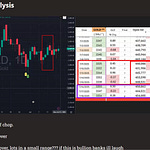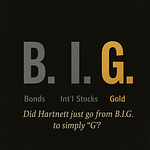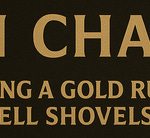Housekeeping: Good Morning
Contents
Intro
Discussion Outline
Slides
Intro:
Sunday’s weekly discussion starts with a long conversation about YCC. The title topic is discussed in context of the CFTC report starts about the 19:00 mark
On a $50 higher move, they sell 2,000 contracts. On a $50 lower move, they cover 20,000 contracts. They're in the market. I know how this works. When you're on the desk- And you're told not to participate or you're told to be careful. You're told to liquidate only.
Discussion Outline:
Introduction to Yield Curve Control (YCC)
Brief discussion on personal trading decisions.
Explanation of yield curve control and common misconceptions.
How YCC typically focuses on lowering long-term yields.
Japan’s Application of Yield Curve Control
Overview of Japan’s YCC strategy.
Impact of capping long-term yields by buying bonds.
Artificial suppression of bond yields and the impact on inflation and investment.
YCC’s Role in Influencing Investor Behavior
Allocators avoiding bonds due to capped yields.
Migration of capital into stocks or leaving the country due to low bond yields.
Hidden strategy to boost stock markets and limit inflation’s discounting in bonds.
Comparison with China's Economic Approach
Comparison of Japan’s YCC with China’s past economic strategies.
Pushing down bond yields to discourage money from sitting idle in bonds.
Encouraging capital to move into more productive investments.
YCC as a Form of Quantitative Easing (QE)
YCC described as targeted QE, specifically aimed at long-term yields.
Effects on the Japanese yen and the bond market.
YCC’s broader impact on the economy and inflation expectations.
Inflation Control and Interest Rates
Explanation of two approaches to fighting inflation: raising short-term rates or allowing long-term rates to rise.
Historical perspective on inflation management from Lehman Brothers.
The role of market confidence in determining the success of rate hikes.
The Mechanics of Yield Curve Inversion
Yield curve inversion explained as a signal for recessions or stagflation.
The relationship between short-term rate hikes and long-term bond yields.
Potential for yield curve inversion and its economic implications.
Market Reactions to YCC
How markets respond to yield curve manipulation.
Speculation on the Fed’s potential use of YCC to slow bond market reactions to inflation.
Impact of market sentiment and confidence on long-term yields.
Federal Reserve Strategy on Inflation
Discussion on Fed’s management of short-term and long-term rates.
How market trust in the Fed can influence long-term bond yields.
The balance between slowing inflation and preventing economic stagnation.
Speculation on Future Yield Curve Control
Anticipation of the Fed’s potential adoption of YCC.
Effects of inflationary pressures on bond yields and market reactions.
Possible scenarios where YCC is employed to manage inflation.
Personal Trading Strategy in Response to Market Conditions
Review of personal trading mistakes and lessons learned.
Discussion of a specific trading pattern: the “fishhook” in market behavior.
How open interest changes can signal market trends.
Market Structure and Open Interest
Detailed breakdown of open interest trends and their significance.
Analysis of market participants, including banks, funds, and swap dealers.
The role of swap dealers and their influence on market movements.
Swap Dealers and Market Making
Role of swap dealers in market liquidity.
Differences between market makers and directional traders.
Insights into the swap dealer behavior and its impact on price movements.
Gold Market Dynamics
Detailed analysis of the gold market, focusing on open interest.
The behavior of different market participants in the gold market.
Speculation on how open interest changes can affect future gold prices.
Impact of BRICS and Other Global Events
Anticipation of BRICS-related developments and their influence on gold.
How international events may affect the gold market and yield curve control.
Predictions about gold price movements and market manipulation by large players like BIS.
Conclusion on Trading Strategy
Final thoughts on market trends, YCC, and potential strategies.
Predictions for gold prices in the lead-up to key global events.
Personal reflections on past trades and future opportunities in the market.
Slides:
Week Covered













